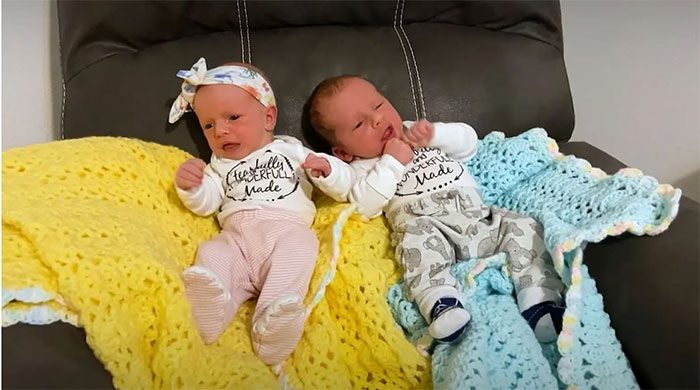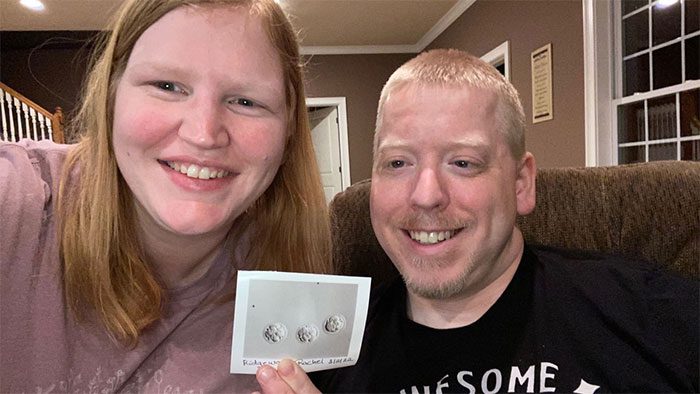On October 31, Lydia and Timothy Ridgeway became the two oldest frozen embryos to successfully develop and be born.
Record for the Oldest Frozen Embryos
According to the National Embryo Donation Center in the United States, the previous record holder was baby Molly Gibson, born in 2020 from an embryo frozen for nearly 27 years. Molly took this title from her sister Emma, who was born from an embryo frozen for 24 years.

Twins Lydia and Timothy Ridgeway. (Photo: NYP).
In fact, experts may have used an even older frozen embryo. However, there is no evidence that an older embryo has led to a successful birth.
“This story is incredible. I was only 5 years old when God gave life to Lydia and Timothy, and He has protected that life,” shared Philip Ridgeway as he and his wife Rachel held their newborn children.
Mr. Ridgeway added, “In a sense, the two babies are our oldest children, even though they are actually our youngest.” The Ridgeway family already has four other children (ages 8, 6, 3, and 2), and none were conceived through in vitro fertilization or donor eggs.
The embryos were originally created for an anonymous couple using in vitro fertilization. The husband was over 50 years old, and they used a 34-year-old egg donor.
These embryos were frozen on April 22, 1992. For nearly three decades, they were stored in small vials kept in liquid nitrogen at a temperature of -200 degrees Celsius, in a device resembling a propane tank.
The embryos were preserved by a fertility lab on the West Coast until 2007, when the couple who created them donated the embryos to the National Embryo Donation Center in Knoxville, Tennessee, hoping that another couple could use them.
A Milestone for Families
SouthEastern Fertility, in collaboration with the National Embryo Donation Center, thawed the embryos on February 28 of this year. Of the five embryos thawed, two did not survive. Experts report that the survival rate of embryos after thawing is about 80%.
The American Society for Reproductive Medicine and the Centers for Disease Control and Prevention recommend transferring one embryo at a time, as transferring more increases the chances of multiple births, which poses additional risks to both mother and child. Twins are at a higher risk for premature birth, cerebral palsy, autism, and miscarriage.
Mother Rachel recounted that Dr. John Gordon showed her a photo of three successfully thawed embryos and suggested they only transfer two due to the potential complications of multiple pregnancies. However, she decided to transfer all three embryos.

Mr. Philip and Mrs. Rachel Ridgeway recently welcomed twins from three embryos frozen for nearly 30 years. (Photo: CNN).
The three embryos were implanted in Rachel’s uterus on March 2, 29 years and 10 months after they were frozen. Two of them successfully developed. Studies have found that the rate of frozen embryo transfers resulting in live births is between 25% and 40%.
Experts state that embryos can be frozen indefinitely. “If you are frozen at nearly -200 degrees, biological processes essentially slow down to almost nothing. Therefore, the difference between being frozen for a week, a month, a year, a decade, or two decades is not really significant,” Dr. Gordon explained.
The age of the embryo does not affect the health of the child. What matters more is the age of the woman who donated the eggs to create the embryos.
Understanding Embryo Donation
The medical term for the process that the Ridgeway couple underwent is embryo donation.
When individuals undergo in vitro fertilization, they may create more embryos than they use. The surplus embryos can be cryopreserved for future use or donated for research or to individuals seeking to have children.
Like any other human tissue donation activity, embryos must meet certain safety standards set by the U.S. Food and Drug Administration (FDA), including screening for various infectious diseases.
The National Embryo Donation Center states: “Receiving an embryo is entirely different from legally ‘adopting’ a child, at least in the sense of adopting after birth. However, this terminology allows all parties to conceptualize the process and the reality of raising a child without a genetic relationship.”
The American Society for Reproductive Medicine asserts that applying the term ‘adoption’ to donated embryos is inaccurate, misleading, and can burden the recipients.
Reproductive expert Sigal Klipstein, Chair of the Ethics Committee of the society, added that many people refer to the process of donation as ‘receiving an embryo’, but adoption and donation are not the same.
According to this expert, adoption refers to living children. It is a legal process through which a parent-child relationship is established when one did not previously exist.
She noted that embryo donation is a medical procedure. “That is how we take embryos from a couple or individual and then transfer them to another individual to build a new family,” emphasized Sigal Klipstein.



















































